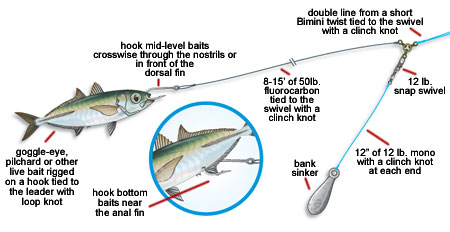Live-Bait spread a bust? fill in the holes and reel in the fish.
By George Poveromo
We were drifting across the slick-calm ocean a few miles off Palm Beach, Florida, and not having a very good day of it. The sailfish had no interest in our spread of live pilchards and goggle-eyes on or near the surface. We even had a livie working the bottom, hoping to scare up a bite 150 feet down. What looked like an ideal day was turning into a bust—I had to act fast.
I considered the spread and quickly realized we were covering the top and bottom of the water column, but not the middle. Sure, we had enticing live baits out there. But when the boat is in 150 feet of water, and the fish show up halfway down the fishfinder screen, that puts them about 75 feet from the nearest bait. Instead of creating a wall of bait that any predator worth its salt could not resist, we had left a gaping hole large enough to drive a school bus—or a school of tuna—through sideways.
Just as a trolling boat's outrigger-assisted spread widens the swath of water it fishes, so should a drift spread cover more water for live-bait anglers.
Think Vertically
I don't need to be a mathematician to divide the water column into five equal zones. If I'm fishing in 150 feet of water, there are five 30-foot depth zones stacked on top of each other. Zone One starts at the surface and goes down 30 feet. Zone Two reaches from 31 feet down to 60 feet, and so on. Predators, such as tuna or kingfish, may tear through baits in the middle zones, while the bottom baits tempt grouper and snapper.
And don't think this technique is just for deep-water drifting. Try it while drifting live baits for such nearshore game as striped bass, tarpon and bluefish, and your catch rate should go up on days when other anglers are struggling.
In an effort to make something happen off Palm Beach, we deepened our spread and put out baits in the three middle water-column zones. After 15 minutes, a 20-pound-class rod went off. It had been soaking a bait about 75 feet down. After stopping the initial run of the fish, I brought a plump, 15-pound blackfin to boatside.
Another blackfin hit the bait at 50 feet down a short while later. After we re-rigged, a nice dolphin struck a bait at that same depth.
Liven It Up
While it takes more effort to tend baits this way, the results are worth it. Over the years, I've saved many a day with action from Spanish mackerel, amberjack, cobia and other gamefish that would have otherwise slipped by. Here are five easy ways to create more effective live-bait drifts.

DEEP END: This rig will put your live bait in the strike zone, with easy-change sinkers and hooks matched to bait size.
Illustration: Pete Sucheski
1. Rule of Threes
Learn to tie the handy three-way rig that I frequently use on subsurface live baits (shown on the next page) for quick and easy sinker changes. Tie up various bank sinkers with short lengths of 12-pound monofilament and snap swivels in advance of a trip. To fine-tune the depth of a bait, simply unsnap the sinker swivel from the three-way swivel and replace it with the desired weight. With a moderate current and slow drift, use an eight-ounce sinker to hold bottom in 100 feet of water. Go heavier if the sinker lifts off the bottom.
2. Get the Drift
Ideally, a drift will take you from shallow to deep, or along a specific depth curve. On the bottom rod, leave the reel in free-spool, activate the clicker and set the rod in a holder. For outfits fishing mid-water baits, engage the full fighting drag. Outfits with larger baits get a slightly loosened drag.
3. Wire Time
If you're fishing in an area where king and Spanish mackerel, barracuda, sharks, wahoo and other toothy fish may show up, consider single-strand wire leaders for the subsurface baits. Otherwise, rig with fluorocarbon.
4. Double Team
A certain depth zone may provide all the action as a feeding school comes through. When this happens, retrieve one of the other, less-productive lines, switch the sinker to match that of the bait that attracted the attention and place another bait at that depth.
5. Slow It Down
If the current is fast, or wind pushes you along quicker than you'd like, use a drift anchor to slow the pace. It will allow you to use lighter weights and fish prime areas more slowly.
These techniques help anglers create their own luck. It's amazing how one strike can energize the boat and refocus the crew on catching fish. And like that day off Palm Beach, sometimes we can all use a jump-start.

